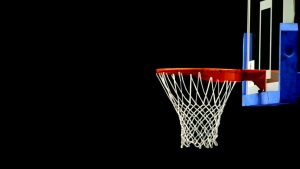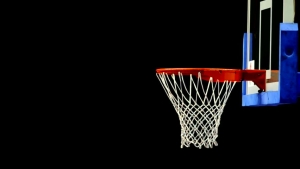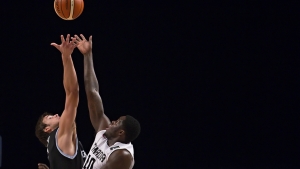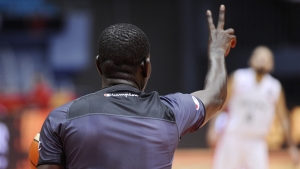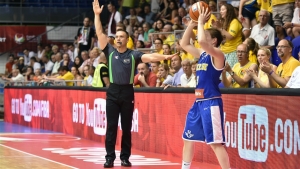Rule Differences
The main FIBA, NBA and NCAA rule differences are summarised in the following table:
| Rule | FIBA | NBA | NCAA |
|---|---|---|---|
| Playing time | 4x10 minutes 5 minutes over-time (OT) |
4x12 minutes 5 minutes over-time |
2x20 minutes 5 minutes over-time |
| Shot clock | 24 seconds After offensive rebound: 14 seconds |
24 seconds | Men: 35 seconds Women: 30 seconds |
| 3-point line | 6.75m (6.60 on baseline) | 7.24m (6.70m on baseline) | Men: 6.25m Women: 6.325m |
| Time-outs | 2 in first half 3 in second half (but only 2 in last two minutes of the 4th period) 1 per OT period Always 60 seconds Never carried over |
6 regular 2 per OT period = 60 or 100 seconds + 1 short time-out (20 seconds) per half The second short time-out can be carried over to OT period !!! additional regulations |
4 regular 30 seconds + long 60 seconds Maximum 3 regular and 1 long in second half !!! additional regulations |
| Jump ball and alternating possession | Jump ball to star game The one losing initial jump ball gets possession for the next jump ball situation Alternating possession between teams thereafter for all jump ball situations |
Jump ball to star game The one losing initial jump ball gets possession to start 2nd and 4th quarters The one winning initial jump ball gets possession to start 3rd quarter All other jump ball situations played as "real jump ball" |
Jump ball to star game The one losing initial jump ball gets possession for the next jump ball situation Alternating possession between teams thereafter for all jump ball situations Jump ball to start OT |
| Individual foul | Foul out on 5 (personal and technical) | Foul out on 6 or 2 technical | Foul out on 5 (personal and technical) |
| Team fouls and bonus free-throws | 2 free-throws awarded for each (non-shooting) foul after the 4th period (includes player technical fouls) Does not include offensive fouls/fouls by team in possession |
2 free-throws awarded for each foul after the 4th team foul or last two minutes of each quarter, whichever comes first Does not include offensive fouls and technical fouls |
1 free throw, plus another if the first is successful is awarded on the 7th, 8th and 9th foul of each half; the penalty is increased to two shots on the 10th and subsequent fouls; overtime is an extension of the second half. Does not include offensive fouls |
| Technical foul (penalty) |
1 free throw and possession of the ball at centre | 1 free throw per technical foul; play resumes at the point of interruption; foul is charged to individual in question (and automatic fine assessed) | 2 free throws, play resumes at point of interruption |
| Goaltending/basket interference | No blocking a ball in downward flight towards the rim. Once the ball strikes the rim, any player can play the ball (i.e. swat it away or tap it in) |
No blocking a ball in downward flight towards the rim. An imaginary cylinder exists that has the basket as its base. Touching the ball while |
Basic Rules
Teams/number of players
Two teams of maximum 12 players, with a maximum of five players of each team on the court at any time.
Teams may make as many substitutions as they like.
The objective
The objective of the game is to put the ball in the opposing team’s basket.
The team with the most points at the end of the game wins.
Duration
The game consists of four periods of 10 minutes.
If the scores are tied, overtime periods of five minutes will be played until one team has more points than the other (at the end of the 5-minute period)
Scoring
A basket scored from near the basket (inside the three-point arc) is worth two points.
A basket scored from far (beyond the three-point arc) is worth three points.
A basket scored from the free-throw line is worth one point.
Moving the ball
The ball may either be passed from one player to another, or dribbled by a player from one point to another (bounced while walking or running).
Before passing or shooting the ball, a player may take two steps (without dribbling).
Once a player has stopped dribbling, he may not start to dribble again.
Once the team in possession of the ball has passed the half-court line, it may cross back over the line with the ball.
Shot clock
When a team gains possession of the ball, they have a maximum of 24 seconds to attempt a shot.
Additionally, offensive players may not remain within the restricted area (key) for more than three consecutive seconds.
Fouls
A personal foul occurs when there is illegal contact between two opponents. A player who makes more than five personal fouls is excluded from the game.
A foul made on a player attempting a shot results in the awarding of the same number of free-throws as those of the shot taken (two from inside the arc, three from outside). If a player is fouled but makes the attempted shot, the shot counts and an additional free-throw will be awarded.
Once a team has made four fouls in a period, each additional foul (on a player not attempting a shot) will result in the automatic awarding of two free-throws.
Rules of the Game
At the most basic level, the rules of basketball make it an easy game to learn and a simple game to play. However, like any sport, once played at an elite level, many additional rules intervene in order to address the many situations that may arise during a competitive game.
FIBA decides, publishes and adapts the Official Basketball Rules, which are the only basketball rules recognised internationally. They are comprehensive and address all rule-related aspects of the game.
FIBA 5-on-5 rules differ slightly from NBA, WNBA and NCAA rules.
The basic basketball rules are explained in the below video:

